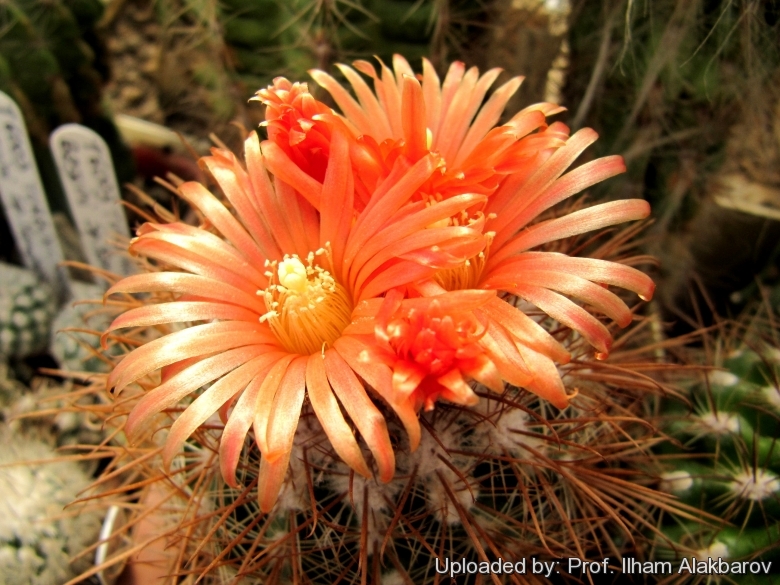Accepted Scientific Name: Parodia procera F.Ritter
Taxon 13: 117. 1964

Parodia andreae Photo by: Prof. Ilham Alakbarov
Origin and Habitat: Bolivia.
Synonyms:
See all synonyms of Parodia procera
back
Accepted name in llifle Database:Parodia procera F.RitterTaxon 13: 117. 1964Synonymy: 16
back
Common Names include:
RUSSIAN (Русский): Пародия Андре
Description: Parodia andreaeSN|5820]]SN|5835]] is a local or morphological form of the wide ranging and variable Parodia proceraSN|5820]]SN|5820]] distinguished by light red-brown spines, large white-felted areoles and showy golden-orange flowers around the very woolly stem apex in mid summer. The differences with other Parodia proceraSN|5820]]SN|5820]] are in reality very minimal and most botanist agree on the fact that both should all be included in the Parodia proceraSN|5835]]SN|5820]], and the two plants are not readily distinguishable, if not for the geographical provenance.
Habit: This species is usually solitary, sometimes forming clumps.
Stems: Globose to elongate, 10-12 cm in diameter, with white woolly tips.
Ribs: Approx 13 more or less vertical, well defined, 5-8 mm hight and tuberculate.
Areoles: Large, white-felted and densely set.
Central spines: Up to 7, brownish or light red-brown, mostly straight, subulate, 2-2,5 cm long.
Radial spines: About up to 20, dull white to yellow-brown, thin, straight, 1-1,5 cm long.
Flowers : Golden orange, 3 cm long and 4-5 cm in diameter; pericarpels and floral tubes with white hairs below, brown hairs and bristles above.
Blooming season: Flowering occurs in summer through early fall and will bloom several times during warm weather.
Fruits: Almost spherical, brownish, small, up to 4 mm in diameter.
Seeds: Small, brownish, shiny.
Subspecies, varieties, forms and cultivars of plants belonging to the Parodia procera group
Bibliography: Major references and further lectures
1) Edward Anderson “The Cactus family” Timber Press, Incorporated, 2001
2) James Cullen, Sabina G. Knees, H. Suzanne Cubey "The European Garden Flora Flowering Plants: A Manual for the Identification of Plants Cultivated in Europe, Both Out-of-Doors and Under Glass" Cambridge University Press, 11/Aug/2011
3) David R Hunt; Nigel P Taylor; Graham Charles; International Cactaceae Systematics Group. "The New Cactus Lexicon" dh books, 2006
4) Friedrich Ritter “Kakteen in Suedamerika: Ergebnisse Meiner 20 Jaehrigen Feldforschungen” F. Ritter Selbstverlag, 1979
5) Hiroshi Hirao “Colour encyclopaedia of cacti” Seibundo Shinkosha, 1979
6) Lowry, M. 2013. Parodia procera. In: IUCN 2013. “IUCN Red List of Threatened Species.” Version 2013.2. <www.iucnredlist.org>. Downloaded on 18 February 2014.
7) Urs Eggli, Leonard E. Newton “Etymological Dictionary of Succulent Plant Names” Springer, Berlin/Heidelberg 2010
8) Friedrich Ritter: “Diagnosen von neuen Kakteen.” In: Taxon. 13(3): 117 1964
Cultivation and Propagation: Parodia andreaeSN|5835]]SN|5835]] is relatively easy to grow on its own roots.
Soil: Grow it in an open sandy-gritty cactus compost.
Pots: It needs a relatively shallow pot to accommodate its fibrous roots and provide a very good drainage. It may stay in the same pot for many years.
Watering: Water in moderation, it prefer a completely dry place during winter. Mature individuals easily rot and die especially after planting so be extremely cautious with watering. Keep dry in winter or when night temperatures remain below 10° C. Water it less than average if in bigger pots.
Special need: Provide very good ventilation. Nearly all problems occur as a result of overwatering and poor ventilation, especially when weather conditions are dull and cool or very humid.
Fertilization: Feed them once during the growing season with a fertilizer specifically formulated for cactus and succulents (high potash fertilizer with a dilute low nitrogen), including all micro nutrients and trace elements diluted to ½ the strength recommended on the label. They thrive in poor soils and need a limited supplies of fertilizer to avoid the plants developing excess vegetation, which is easily attacked by fungal diseases.
Exposure: It will do its best with lots of sun and become stressed with inadequate light which could result in poor growth and unnatural shape.
Hardiness: It likes warmth (recommended minimum winter temperature 5° C) however plants kept perfectly dry can can survive low temperatures, approx. -5°, but for safe cultivation it is best to avoid freezing temperatures.
Use: This is a good pot plant suited for a non heated green house. It can be also cultivated outdoors in raised beds, terraces if sheltered from winter rain. This cactus continues to be, a particular prize among collectors
Pests & diseases: These cacti may be attractive to a variety of insects, but plants in good condition should be nearly pest-free, particularly if they are grown in a mineral potting-mix, with good exposure and ventilation. Nonetheless, there are several pests to watch for:
- Red spiders: Red spiders may be effectively rubbed up by misting the plants from above.
- Mealy bugs: Mealy bugs occasionally they develop aerial into the new leaves and flowers with disfiguring results, but the worst types develop underground on the roots and are invisible except by their effects.
- Rot: Rot is only a minor problem if the plants are watered and “aired” correctly. If they are not, fungicides won't help all that much.
Propagation: Seeds. The seeds can be sown in pots of fine, well-drained sandy soil, any time during the spring when temperatures are warm. Cover the seeds with a fine layer of grit and water from below with a fungicide to prevent damping off. For the 1-2 weeks cover the pots with a sheet of glass/clear perspex to keep the humidity levels high. Remove the glass and replace it with light shade-cloth and mist once or twice a day for the next two weeks after which most seeds should have germinated. From then on mistings can be reduced to every second and then every third day as the little plants grow.










